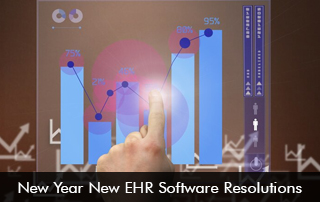A new year means new resolutions and the EMR software resolutions for 2024 are no different. From leveraging technology to improve patient outcomes, streamline workflows, and ensure the delivery of high-quality healthcare services, healthcare providers have a lot on their lists. Let’s look at our list of Electronic Medical Record (EMR) software resolutions.
EMR Software Investing in Advanced Analytics for Informed Decision-Making
In 2024 healthcare organizations should resolve to harness the power of advanced analytics within their EMR systems. Analyzing patient data, trends, and outcomes can provide valuable insights for informed decision-making. By leveraging predictive analytics, healthcare providers can identify potential health risks, personalize treatment plans, and allocate resources more efficiently. Investing in advanced analytics ensures data-driven decisions that ultimately enhance patient care and contribute to better overall outcomes.
Enhancing Interoperability for Seamless Information Exchange
Interoperability remains a crucial resolution for healthcare organizations in the new year. EMR systems should seamlessly integrate with other healthcare technologies, facilitating the exchange of information across different platforms. Improved interoperability ensures that patient records, diagnostic results, and treatment plans can be easily accessed. This resolution aims to break down data silos, reduce inefficiencies, and create a more connected healthcare ecosystem.
EMR Software Prioritizing User Experience and Streamlining Workflows
User experience plays a pivotal role in the successful adoption and utilization of EMR systems. In the new year, healthcare organizations should resolve to prioritize user-friendly interfaces and streamlined workflows. This involves optimizing the design of the EMR software to enhance accessibility and reduce the learning curve for healthcare professionals. By ensuring a positive user experience, organizations increase staff satisfaction, minimize errors, and ultimately deliver more efficient and patient-focused care.
Embracing Mobile Accessibility for Flexibility and Patient Engagement
In 2024, the resolution to embrace mobile accessibility is essential for healthcare organizations looking to stay ahead in the digital age. Mobile EMR applications empower healthcare professionals to access patient information on the go, leading to improved flexibility and responsiveness. Moreover, mobile accessibility fosters greater patient engagement by providing individuals with convenient access to their health records. They can also schedule appointments and access treatment plans. This resolution aligns with the evolving expectations of both healthcare providers and patients for a more connected healthcare experience.
EMR Software Committing to Regular Software Updates and Security Measures
Cybersecurity threats continue to pose a significant risk to healthcare organizations, making it imperative to prioritize the resolution of committing to regular software updates and robust security measures. EMR software should be regularly updated to incorporate the latest security patches, features, and compliance standards. Healthcare organizations must resolve to implement multi-layered security protocols, conduct regular vulnerability assessments, and educate staff on cybersecurity best practices. This commitment ensures the protection of sensitive patient data, maintaining trust and compliance with regulatory requirements.
Fostering Collaboration Between IT and Clinical Staff
Effective collaboration between IT teams and clinical staff is crucial for the successful implementation and optimization of EMR systems. In the new year, healthcare organizations should resolve to break down communication barriers and foster a collaborative environment between these two essential components. This resolution involves providing ongoing training, creating interdisciplinary teams, and establishing clear communication channels. By aligning IT objectives with clinical needs, organizations can ensure that EMR systems are effectively utilized to improve patient care and operational efficiency.
Customizing EMR Software to Meet Specific Organizational Needs
No two healthcare organizations are alike, and as such, EMR solutions should be customizable to meet specific organizational needs. The resolution to customize EMR software involves working closely with vendors to tailor the system to the unique workflows, preferences, and goals of the healthcare facility. This customization ensures that the EMR system becomes a strategic asset rather than a one-size-fits-all solution, contributing to increased efficiency and satisfaction among healthcare professionals.
EMR Software Promoting Patient Data Privacy and Ethical Use
Patient data privacy and ethical use of health information are critical considerations in the digital age of healthcare. As a resolution, healthcare organizations should prioritize implementing policies and practices that safeguard patient confidentiality and ensure the ethical use of data. This involves educating staff on privacy best practices, obtaining informed consent for data usage, and maintaining transparency in data-sharing practices. By prioritizing patient data privacy, healthcare organizations can build and maintain trust with their patient communities.
These resolutions pave the way for improved patient outcomes and increased efficiency. We at EMRFinder are dedicated to helping you locate EMR software that is more connected, responsive, and patient-centric. Happy New Year!









